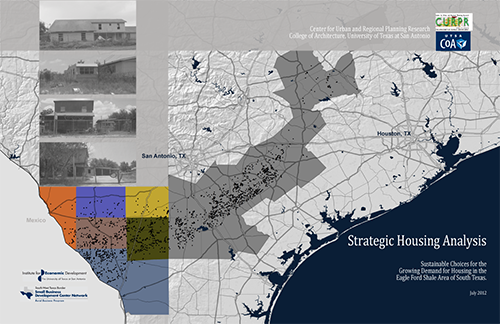Affordability is Eagle Ford Shale’s Most Prominent Housing Need
UTSA PROJECTS POPULATION OF SIX WESTERN COUNTIES WILL GROW TO 86,297 BY 2025
Young families with school-aged children will continue to account for a significant portion of newcomers to six Eagle Ford Shale counties, according to a study released today by the Small Business Development Center (SBDC) at The University of Texas at San Antonio (UTSA) Institute for Economic Development. Researchers Azza Kamal and Richard Tangum in the UTSA College of Architecture and Center for Urban and Regional Planning Research completed the Eagle Ford Shale Strategic Housing Analysis, which examines the state of housing in Dimmit, Frio, La Salle, Maverick, Webb and Zavala Counties.
Download the study at http://bit.ly/EFS-Housing.
“The Eagle Ford Shale oil and gas play is one of the most significant oil and gas finds in Texas history, and it has attracted an influx of transient and permanent workers from across Texas and the nation,” said Gilbert Gonzalez, SBDC director. “As we look 10 to 15 years into the future, it is clear that housing stock, public service, infrastructure and public utilities will need to be improved and expanded to accommodate the influx of new residents.”
The study concludes:
- From 2000 to 2010, the population in the six-county region grew by 65,958 people, and housing grew by 21,805 units.
- The housing occupancy rate hovered around 89 percent in 2000 and 2010, suggesting that the population and housing growth in the six-county region increased proportionally.
- The median household income in the six-county region, which ranges from $21,707 to $36,684, is sharply lower than the median income in Texas and the nation. (U.S. Census 2010)
- Housing units in the area need to include a flexible design approach that can adapt to changes in demographics after the extraction activities of oil and gas has ended.
- Vacant housing units in all shale counties need to be further analyzed because they offer strong potential if resources can be allocated for rehabilitation and home-repair programs.
UTSA researchers suggest that new permanent housing in the shale region should include a combination of detached single-family units and attached multi-family units. Mixed-use development is highly desired in the large communities. Moreover, the optimal placement for new residential developments is within 15.5 miles driving distance to work sites in the six-county region studied. Strategic locations for new developments include Carrizo Springs (Dimmit County), Crystal City (Zavala County), Dilley and Pearsall (Frio County), Cotulla (La Salle County) and Laredo (Webb County).
The study also says affordable temporary, mobile and rental housing units are needed to accommodate the region’s newcomers. Approximately 77.5 percent of the hotels studied were 90 percent booked by people planning to stay for 30 or more days. Researchers found this trend causes an economic burden for those communities because those long-term guests are not required to pay the Hotel Occupancy Tax.
“Affordability and sustainability of housing solutions are the most important lessons uncovered by this study,” said Kamal, the study’s principal investigator. “Policy leaders need to keep housing prices at rates that are affordable for local residents and the newcomers to maintain a positive quality of life for everyone living in the shale region.”
The Eagle Ford Shale is a 50 mile-wide by 400 mile-long formation that runs from the southern portion of Texas to the east. The formation produces natural gas, condensate, oil, and natural gas liquids, with margins more favorable than other shale plays. Last year, the 20-county region generated more than $25 billion in revenue for South Texas, according to a study released in May 2012 by the Center for Community and Business Research at the UTSA Institute for Economic Development.
Written by Christi Fish
Associate Director of Media Relations, The University of Texas at San Antonio




